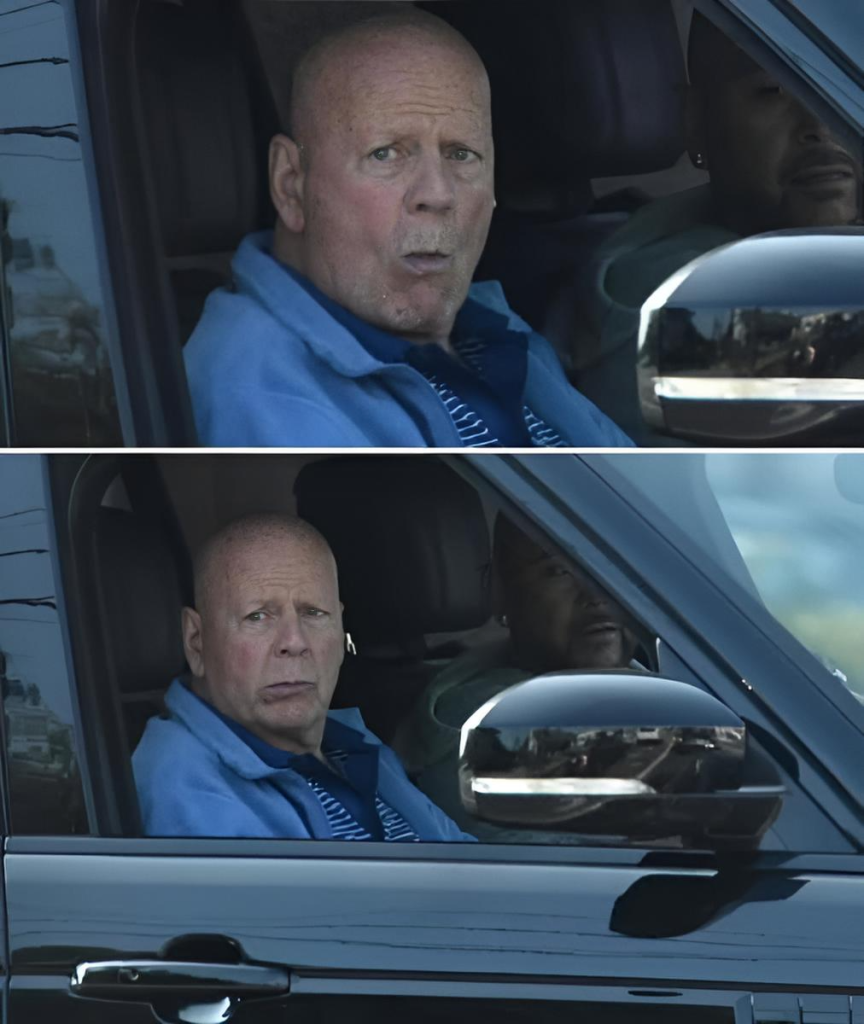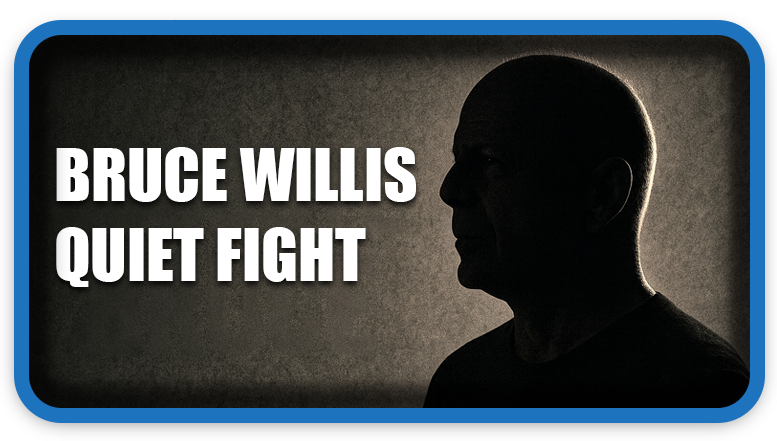⏲️ Estimated reading time: 11 min
Hollywood icon Bruce Willis now receives round-the-clock care in a separate, safer home tailored to his needs as frontotemporal dementia (FTD) progresses. Wife Emma Heming Willis explains the decision, the family’s daily rhythm, and what compassionate caregiving looks like when words fade. (People.com)
A beloved star in a different kind of spotlight
For four decades, Bruce Willis embodied the swaggering everyman: the sardonic cop crawling through air ducts, the reluctant hero cracking a half-smile as the world fell apart around him. That screen image is indelible. Today, however, the spotlight has shifted. The 70-year-old actor lives more quietly, supported by professional, round-the-clock caregivers in a second home specifically adapted to reduce agitation and overstimulation arrangements his wife, Emma Heming Willis, says best fit his medical needs as he lives with frontotemporal dementia (FTD). (People.com)
Recent interviews and a prime-time special with Diane Sawyer have given the public a more nuanced, compassionate view of what the family is navigating. Emma has described how noise, crowds, and changing environments can overwhelm people with FTD; the “separate home” decision, she says, is about safety, routine, and dignity not distance or abandonment. She remains deeply present in his life, visiting daily and coordinating care alongside their blended family. (People.com)
What is frontotemporal dementia and why words can fade first
Unlike Alzheimer’s, which often begins with memory lapses, FTD typically strikes the brain’s frontal and temporal lobes, affecting behavior, judgment, personality, and language. Bruce’s public journey started with an aphasia diagnosis in 2022 (a language disorder impairing speech and comprehension), followed by confirmation of FTD in 2023. In FTD, “language is going,” Emma shared an honest, heartrending phrase that captures both the clinical reality and the emotional weight of communication losses. (People.com, The Guardian)
FTD often progresses faster than other dementias. Sensory stimuli (lights, sound, crowded spaces) can trigger anxiety or agitation. That’s why clinicians emphasize structured routines, simplified environments, predictable caregiving teams, and compassionate communication techniques short sentences, visual cues, touch, and eye contact. The family’s housing choice aligns with those best practices. (ABC News)
The family’s choice: proximity without constant stimulation
Misunderstandings flourish when a famous family makes private medical decisions in public view. Social media hot takes asked: “Why separate homes?” The answer, according to Emma, is clinical and humane: a customized, calmer environment for Bruce, paired with daily family contact and continuity of care. She has addressed the “loud opinions,” reminding observers that lived caregiving experience not online judgment shapes responsible choices. (People.com, E! Online)
Coverage has sometimes used shorthand like “moved into a facility.” Emma’s phrasing emphasizes a “second” or “separate” home and a care team language that highlights autonomy and tailoring rather than institutionalization. Media reports also reference 24/7 support, a practical necessity once language, safety awareness, and executive function decline. (People.com, Yahoo)
When the words won’t come: connection beyond conversation
Fans naturally wonder: can Bruce still speak? Reports indicate that communication is significantly affected consistent with aphasia and FTD and that “language is going.” Yet connection has many forms. Emma has spoken about flashes of his unmistakable humor, a signature grin, a spark in his eyes. Caregivers often look for these micro-moments nonverbal cues, a chuckle, a squeeze of the hand as evidence that relational bonds persist even when vocabulary does not. (The Guardian, https://www.kbtx.com)

It’s vital to avoid absolutist claims like “he cannot speak or remember anything.” Dementia is a spectrum; abilities can fluctuate. Some days bring clarity; others are clouded. The family’s disclosures emphasize compassion over clinical detail, protecting Bruce’s dignity while raising awareness for millions facing similar journeys. (People.com)
A career that redefined the action hero
Before this chapter, Bruce Willis re-wrote the action rulebook. Die Hard (1988) turned vulnerability into a superpower, birthing the quippy, bruised-and-bleeding hero archetype. Across Die Hard sequels, Pulp Fiction, 12 Monkeys, The Fifth Element, The Sixth Sense, Unbreakable, Looper, and dozens more, he showed range far beyond one-liners: haunted, comic, offbeat, melancholy. He recorded albums, parodied himself, took risks.
That fullness matters now. When language thins, legacy thickens. Old movies, family videos, and music become memory anchors for loved ones and for us. The public may not see him on red carpets, but the work remains everywhere: streaming queues, cable reruns, and generational movie nights.
Emma’s role and the reality of caregiving
If Bruce embodied cinematic grit, Emma now embodies real-life resilience. Her interviews describe a caregiver’s triad: advocacy (coordinating clinicians and therapies), environment (reducing triggers, maintaining routines), and endurance (managing grief, stress, and hope). She’s also writing about it in a forthcoming book, turning private lessons into public lifelines for other families. As online judgment swelled, she reminded critics that choices are made first for the patient’s comfort and safety. (People.com, The Guardian)
Caregiving is physically taxing and emotionally complex. Spouses wrestle with ambiguous loss: the person is here, but not quite here. Frustration and love coexist. Good days can look ordinary; bad days can feel bottomless. Emma’s candor helps normalize that complexity and points others toward support.
Why “separate” can mean closer: safety, structure, and dignity
Let’s unpack why a separate, specialized home can be an act of closeness:
- Sensory control: FTD can amplify sensitivity to light, sound, and crowds. A quieter space reduces agitation.
- Predictability: Consistent routines and a stable team reduce confusion.
- Risk management: 24/7 oversight mitigates wandering, falls, and household hazards.
- Rest for loved ones: Caregiver burnout is real. Sustainable rhythms protect everyone.
- Dignity first: Tailored spaces preserve autonomy fewer stimuli, more calm, familiar comforts.
These principles are echoed by neurologists and dementia-care guidelines and align with Emma’s explanations on national television. (ABC News)
The ABC special and a wider conversation
The ABC News conversation with Diane Sawyer, amplified by major outlets, didn’t sensationalize; it humanized. Viewers saw an unvarnished portrait of a family adapting, a spouse learning a new language of care, and a community facing FTD without a Hollywood script. Critics and fans alike called the special unexpectedly moving; UK press framed it as sincere and insightful rather than sentimental fluff. (The Guardian)
With that visibility comes noise. Some tabloids lean into speculation; some social posts misstate facts. The antidote is simple: listen to primary voices (Emma, the family), and to reputable health reporting rather than rumor. (People.com)
Myths vs. realities of FTD
Myth 1: “FTD only affects memory.”
Reality: It frequently begins with behavior or language changes; memory may be relatively intact early on. Aphasia trouble finding or understanding words is common. (ABC News)
Myth 2: “A person with FTD is ‘gone.’”
Reality: Personality expression can still flicker through nonverbal cues, humor, and routines. Many families report treasured moments even as disease progresses. (The Guardian)
Myth 3: “Facilities or separate homes mean abandonment.”
Reality: Structured environments can increase safety and comfort. Families often remain intensely involved, just in a sustainable way. (People.com)
Myth 4: “Public figures owe constant updates.”
Reality: Medical privacy and dignity come first. Selective sharing can educate without exploiting.
Practical takeaways for families facing FTD
- Get a precise diagnosis. “Dementia” is an umbrella term. Knowing it’s FTD guides the right therapies and expectations. (ABC News)
- Build a sensory-smart home. Minimize noise, glare, and clutter; post simple visual cues; keep a consistent daily rhythm.
- Communicate differently. Use short phrases, gestures, and eye contact; avoid open-ended questions; validate feelings more than facts.
- Assemble a circle. Neurologist, speech-language pathologist, occupational therapist, social worker, respite services, and crucially friends who show up.
- Protect the caregiver. Schedule respite. Say yes to help. Grieve in motion. Journaling and support groups reduce isolation.
- Document wishes early. Advance directives and powers of attorney lower stress later.
- Celebrate small wins. A shared song, a laugh, a walk in sunshine these moments matter.
Bruce’s legacy: rewatching with new eyes
Revisiting Willis’s filmography now carries extra resonance. Die Hard remains the template: a regular guy whose grit outpaces his circumstances. The Sixth Sense reminds us that presence and listening can change everything. Unbreakable and Looper show a star unafraid of genre risks. Even his comedies Moonlighting to self-parodying cameos reveal timing and warmth that feel, in hindsight, like gifts left everywhere for us to find.
For fans, rewatching isn’t nostalgia; it’s a form of gratitude. Streaming his movies, buying a soundtrack, or introducing a younger viewer to Die Hard is a way to honor the artist while respecting the person’s privacy now.
Public reaction: loud opinions vs. quiet truths
When Emma spoke about the separate home, the internet did what it does speculated, second-guessed, and projected. She responded with grace but firmness: choices belong to the family and the care team; onlookers don’t carry the 3 a.m. worry or track the medication schedule. That boundary is healthy, and it models how to navigate public scrutiny with a clear spine and a soft heart. (People.com, E! Online)
Why this story matters beyond celebrity
Millions worldwide confront dementia. When a high-profile family shares their path, stigma recedes. We collectively learn that language can falter while love adapts; that safety plans can coexist with tenderness; that separation on paper can be closeness in practice. The Willis family’s openness has sparked donations, volunteerism, and conversations at kitchen tables far from Hollywood. (The Guardian)
Frequently asked questions (for readers who just tuned in)
Is Bruce Willis currently in a hospital or traditional facility?
His wife describes a “second home” tailored to his needs with 24/7 care, not a hospital. The setup reduces agitation and maintains routine while keeping the family closely involved. (People.com)
Does he still speak?
Reports emphasize significant language decline consistent with aphasia and FTD. Families often communicate through touch, expressions, and short phrases; abilities can vary day to day. (The Guardian)
Why live separately from his wife and children?
To minimize environmental triggers and maintain a stable, specialized care routine. Emma has addressed public criticism, underscoring that this plan prioritizes Bruce’s comfort and safety. (People.com)
How did this begin?
In 2022 the family revealed an aphasia diagnosis and Bruce’s retirement from acting; in 2023 they shared that doctors had identified FTD. (People.com)
Where can I learn more about FTD?
Trusted health agencies and neurology clinics provide practical guides on symptoms, progression, and caregiver support; Emma’s recent interviews also offer first-person insights. (ABC News, People.com)
For caregivers reading this
If you’re living a version of this story, you are not alone. Consider building a weekly cadence medical check-ins, family updates, respite blocks, and your own wellness slots (walks, therapy, sleep). Small routines compound into survivable months. Keep a short “wins” list on the fridge. Reach out to one friend who offers practical help over platitudes. Above all, remember: accepting help is an act of love, not weakness.
A note on language, privacy, and respect
It’s tempting to make definitive statements about what Bruce “can no longer do.” But the family’s own words should guide us. They’ve shared enough to orient our compassion and withheld enough to protect his dignity. That balance is the standard we should extend to any person living with dementia, famous or not. (People.com)
Final Takeaway
Bruce Willis’s story has moved from explosive set pieces to a quieter kind of courage the perseverance of a family adapting to frontotemporal dementia with honesty and love. The decision to create a separate, tailored home with 24/7 care isn’t a withdrawal; it’s an embrace of what his condition demands, a practical expression of devotion. Through Emma’s voice we learn how to meet FTD where it lives: in routines, calm spaces, patient eyes, and the unglamorous heroics of daily caregiving. As words recede, the work he left behind speaks for him and the people who love him most make sure he’s still heard. (People.com, The Guardian)
🔔 For more tutorials like this, consider subscribing to our blog.
📩 Do you have questions or suggestions? Leave a comment or contact us!
🏷️ Tags: Bruce Willis, frontotemporal dementia, aphasia, Emma Heming Willis, celebrity health, caregiving, dementia awareness, Diane Sawyer special, Hollywood icons, mental health support
📢 Hashtags: #BruceWillis, #FrontotemporalDementia, #Aphasia, #Caregiving, #EmmaHemingWillis, #DementiaAwareness, #HollywoodIcon, #DieHard, #MentalHealth, #FamilySupport
Key recent reporting and context referenced in this article include Emma Heming Willis’s ABC News interview and follow-up coverage noting a “separate/second home” tailored to Bruce’s needs, round-the-clock care, and her public response to criticism. (People.com, ABC News)
Only logged-in users can submit reports.
Discover more from HelpZone
Subscribe to get the latest posts sent to your email.

